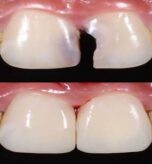Whether you’re self-conscious about a chipped tooth, discoloration, or a small gap, dental bonding offers a simple, affordable, and minimally invasive way to improve your smile. But what exactly is it—and how long can you expect the results to last?
In this comprehensive guide, we’ll answer the top questions about dental bonding, including its benefits, durability, comparisons with other cosmetic treatments, and expert-backed tips to make your bonding last as long as possible.
What Is Dental Bonding?
Dental bonding is a cosmetic dental procedure where a tooth-colored composite resin is applied to the surface of a tooth to repair, reshape, or improve its appearance.
Common Uses of Dental Bonding Include:
- Fixing chipped or cracked teeth
- Closing gaps between teeth
- Improving tooth discoloration
- Changing the shape of teeth
- Protecting exposed tooth roots due to gum recession
Why it’s called “bonding”: The resin “bonds” to your natural tooth structure using a special adhesive and curing light.
Users are generally:
- Seeking a cost-effective cosmetic fix
- Comparing bonding with other dental treatments
- Curious about longevity, maintenance, and value
- Trying to improve their smile quickly for a special event
Dental Bonding vs. Veneers vs. Crowns
| Feature | Dental Bonding | Veneers | Crowns |
| Cost | $100–$600/tooth | $900–$2,500/tooth | $1,000–$3,000/tooth |
| Durability | 3–10 years | 10–20 years | 15–25+ years |
| Invasiveness | Minimal | Requires enamel removal | Extensive reshaping needed |
| Reversibility | Yes | No | No |
| Ideal For | Minor flaws | Moderate cosmetic changes | Major damage or restoration |
Expert Tip: Bonding is often a good starting point for minor aesthetic issues, especially for younger patients or those not ready to commit to permanent solutions.
How Long Does Dental Bonding Last?
The lifespan of dental bonding depends on several factors, but on average, it lasts 3 to 10 years.
Factors That Affect Bonding Longevity:
- Location of the bonded tooth (front teeth usually last longer than molars)
- Biting habits (grinding or biting nails can shorten lifespan)
- Oral hygiene routine
- Diet (staining foods and drinks can affect color)
- Smoking or tobacco use
- Quality of application and dental materials used
How to Make Dental Bonding Last Longer
To extend the life of your dental bonding:
- 🪥 Brush and floss daily
- 🚭 Avoid smoking or chewing tobacco
- 🍷 Minimize coffee, red wine, and staining foods
- 🦷 Use a mouthguard if you grind your teeth at night
- 🤐 Don’t chew ice, pens, or fingernails
- 🦷 Visit your dentist regularly for cleanings and exams
Does Dental Bonding Stain?
Yes, the composite resin used in dental bonding can stain over time, especially with frequent exposure to:
- Coffee and tea
- Red wine
- Curry, berries, and other highly pigmented foods
- Cigarettes or vaping
However, unlike natural enamel or porcelain veneers, bonding can’t be whitened with bleaching treatments. If discoloration occurs, your dentist may recommend re-polishing or replacing the bonded area.
Benefits of Dental Bonding
- Affordable and accessible compared to other cosmetic options
- Fast, in-office treatment—often completed in a single visit
- Non-invasive and reversible
- Natural-looking results with minimal enamel removal
- Great for kids, teens, and adults alike
Who’s a Good Candidate for Dental Bonding?
You’re likely a great candidate if you:
- Want to repair minor cosmetic issues
- Have healthy teeth and gums
- Are looking for a reversible or temporary fix
- Aren’t ready for veneers or crowns
It’s ideal for front teeth and minor corrections. For larger restorations, your dentist may suggest veneers or crowns.
Share This with Someone Considering a Smile Makeover
Know a friend or family member considering a smile upgrade but not ready for veneers or braces?
Share this article with them—it could be the solution they’ve been looking for!
- How long does dental bonding last on front teeth?
- Can dental bonding fall off?
- Dental bonding vs veneers cost
- How to fix a chipped tooth quickly
- Cosmetic dental bonding near me
Final Word
So, what is dental bonding, and how long does it last?
Dental bonding is a quick, affordable cosmetic dental treatment that can enhance your smile by fixing chips, discoloration, and small gaps. With proper care, bonding can last up to 10 years or more, making it a smart choice for those seeking non-invasive smile improvements.
Common FAQs About Dental Bonding
Q:1. Is dental bonding painful?
A: Not at all. Bonding usually requires no anesthesia unless it’s being used to fill a cavity.
Q:2. Can bonding fix gaps in teeth?
A: Yes! It’s a popular, quick solution for closing small gaps without braces or aligners.
Q:3. How long does the procedure take?
A: Usually between 30–60 minutes per tooth. Often completed in one visit.
Q:4. Is dental bonding covered by insurance?
A: If it’s for cosmetic purposes, typically no. But if used for a restorative reason (e.g., repairing a chip), partial coverage may apply.



